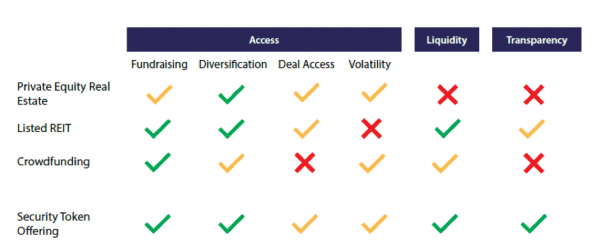In the latest Bayfield Training Webinar, Sonia Martin-Gutierrez and Andri Rabetanety present: An Introduction to Real Estate Tokenization. Tokenisation implies two innovations in real estate investing: the fractionalisation of property rights and digital representation of ownership. In this webinar, Andri provides a broad overview of the real estate tokenization space and the challenges it faces. The webinar equips you with understanding the opportunities and risks to implement tokenization in your real estate strategies.
What is Real Estate Tokenization?
Tokenization is a process that attaches fractional asset ownership rights to a unit of a distributed ledger, or token. The rights are represented digitally in the form of a token. Andri explains that tokenization has brought about two innovations, “fractionalisation and digital representation of ownership.” Regarding real estate, fractionalisation is not particularly new—institutional investors are accustomed to fractionalising their real estate exposure in a syndicated structure (i.e. funds). Similarly, private real estate investors can, through crowd-funding platforms, access different types of pooled real estate investments, with a low buy-in threshold. In sum, fractionalisation for both private and public investors is not necessarily a new concept.
Thus, the real innovation for investors seems to be the digital representation of ownership. There are two distinctive possible structures for tokenized assets. First, where the asset is native to the blockchain, the other is the digital representation of an existing asset that exists off-chain. Specifically, the digital representation of shares in a Special Purpose Vehicle (SPV) that is established off-chain. The SPV owns the underlying real estate asset, and the shares in the vehicle are distributed using blockchain. Effectively, blockchain becomes a distribution channel to get access to real estate. Real estate Tokenization is the process of creating a digital asset that represents a single property or a portfolio of properties on a blockchain-based system. The process of creating the tokens is referred to as Security Token Offering (STO). STO is a process whereby a financial instrument is registered with a regulator and then distributed among investors using blockchain technology. To date, CHF 630M worth of real estate investment has been tokenized, and the market is projected to grow by 256% in 2021.
Benefits of Real Estate Tokenization
To begin with, Andri outlined the challenges related to traditional real estate investment. Broadly, real estate is characterized as being lumpy and illiquid. Additionally, there are multiple barriers to entry to gain exposure to real estate, including size and lack of transparency.
Digitization of real estate assets on a blockchain-based system addresses several challenges in capital formation and liquidity. First, Andri describes how it provides access to additional capital. Specifically, real estate owners and developers can offer smaller investment denominations by fractionalizing a property through a blockchain-based system, expanding distribution to a broader and more diverse investor group.
Second, lower illiquidity discounts and liquidity premium. For highly illiquid assets such as real estate, institutional investors have often had an advantage over individuals due to the steep illiquidity discount associated with the majority of commercial real estate investments. Conversely, more liquid investment vehicles, such as publicly-traded REITs, frequently trade at up to a 20% premium. Tokenization of real estate enables a broad variety of assets to trade on a secondary market, thereby reducing the spread between illiquid real estate investments and publicly-traded investment vehicles and bringing an asset’s executable price closer to its real value.

Proof of concept
In the third slide, Andri deals with the proof of concept i.e., empirical evidence of the success of tokenization. The first tokenization deal occurred with the St Regis Hotel, Aspen, in August 2018. The deal was valued at $18 million, providing investors with 19% equity. The tokenization of the St Regis Hotel started a series of ‘proof of concept’ that later followed in 2018. For example, across different asset classes, such as the tokenization of student housing, with the majority of the deals occurring in the USA. In 2019, the proof of concept trend reached Europe, evidenced by the tokenization of several projects, such as student housing in Nottingham (August 2019) and the Ann Villa in France (June 2019).
Nonetheless, Andri stresses that tokenization is “not the silver bullet to all the inefficiencies of real estate investing.” Instead, it provides a more efficient digital layer to real estate investing. It does not change the fundamental aspect of the management of real estate. There is still a need to have a quality asset to realize a good investment. Moreover, tokenization does not create liquidity but instead enables it.
Moving Forward
To conclude, Andri explains the prospects of real estate tokenization. First, the number of technical platforms offering tokenization services (of all kinds) is significantly growing. Current platforms include Token estate, Black Manta, Tokeny solutions. Second, single asset tokenization shows less attractiveness than the tokenization of funds. The tokenization of funds generally involves taking a series/portfolio of properties and tokenizing them as a single pool. This is attractive for investors as it results in fractionalisation. For example, in 2019, asset tokenization firm Liquefy partnered with a consortium of Gulf families on a tokenization project for $1 billion of real estate assets. Third, Andri argues that we will continue to see an evolution of new business models concerning the ownership of real estate. For example, using tokens and fractionalization to provide for more access to affordable housing.
